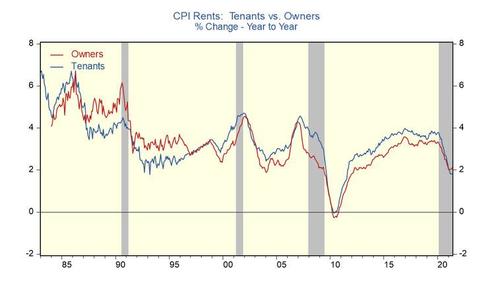By Joe Carson, former chief economist at Alliance Bernstein
The Bureau of Economic Analysis (BEA) is researching the shortcomings of the owner's rent price index it gets from the Bureau of Labor Statistics (BLS) consumer price index as it plans to change its source data for housing services in the GDP accounts. Shifting to a market-based measure of owners' rents in the PCE inflation measure would be an inflation bombshell.
Assuming everything else equal, a market-based measure of owners' rents would permanently lift the PCE inflation, especially during expansions and the dwindling supply of homes for rent, and put an end to the Fed's elusive chase for 2% inflation. The level of official rates would be markedly higher and sit above inflation rather than below. Could a simple change in the measurement of reported inflation end the decades-long bull market in bonds and equities?
Owners Housing Costs
In its May Survey of Current Business, BEA announced that it planned to include a new current dollar estimate for housing services as part of the annual update to the GDP accounts, using data from the American Community Survey. The article stated that the revisions would affect the current dollar estimates and would not affect the deflators for PCE housing services as they planned to continue to use the CPI rental equivalence measure.
BEA has a dual responsibility, providing an accurate estimation, as best possible, of the nominal and real output values. So, I asked a senior official at BEA why they didn't move away from the CPI measure of owners' rent. Using an improper price deflator for owner-housing would over-state the real value of housing services during cyclical upturns and understate PCE inflation.
The senior official responded, "We are currently in the process of researching possible shortcomings of the current rental equivalence price." Saying they are investigating the issue does not mean a change is coming. But in the nearly two decades of researching and writing about how the CPI understates housing inflation, this is the first time a senior official from a government statistical agency (BEA or BLS) stated to me that they were looking into the issue. Progress?
I shared with BEA the research that I presented in 2005 at a panel session, "Housing Costs in the CPI: What Are We Measuring?" at the National Association of Business Economists Annual Meeting in Chicago. The CPI rent index could be statistically explained with a high degree of accuracy by four factors; the vacancy rate in the rental market, the ratio of the vacancy rates in the rental and owners markets, construction cost inflation, and the change in house prices. Of the four, the vacancy rate is the most critical driver of the change in rents.
Employing the same approach but replacing the vacancy rate of the rental market with that of the owner market help create an estimated implicit rent for owner-occupied housing. The estimated implicit rent index tracked the BLS series, but a significant divergence appeared when BLS stopped sampling the owners market in 1998. And during the housing cycle of the 2000s, the estimated implicit rent ran considerably faster than the official BLS series; in other words, the change in sampling led to an understatement of CPI and PCE inflation from what would have occurred had the change not been made.
BLS, in its presentation, agreed "that the rental-vacancy rates influence rents, but that it is not clear how the owner-vacancy rate influences the cost of shelter services for owners." Common sense would tell you that if the vacancy rate is essential in one market, it is equally significant in the other. And it is the relative shift in vacancy rates that drive different rent patterns. Suppose the vacancy rate is declining in the owner's market while stagnant or rising in the tenant market. In that case, one will expect the rental rate in owner housing to be increasing relative to the tenant market. But for the past two decades, the CPI rent series shows the opposite tenant's rents rise faster than owners even with higher vacancy rates.
A market-based measure of owner-occupied rents would have zero effect on the economy. But there would be spillover effects on the economy and finance as policymakers respond to a permanently higher reported PCE inflation rate. That's because the days of monetary policy trying to achieve a 2% inflation rate would be over and replaced by policymakers attempting to limit the cyclical uptick in inflation. The transition would not be seamless, and the payback in finance could be significant as higher reported inflation increases volatility and risks. Stay tuned.

No comments:
Post a Comment